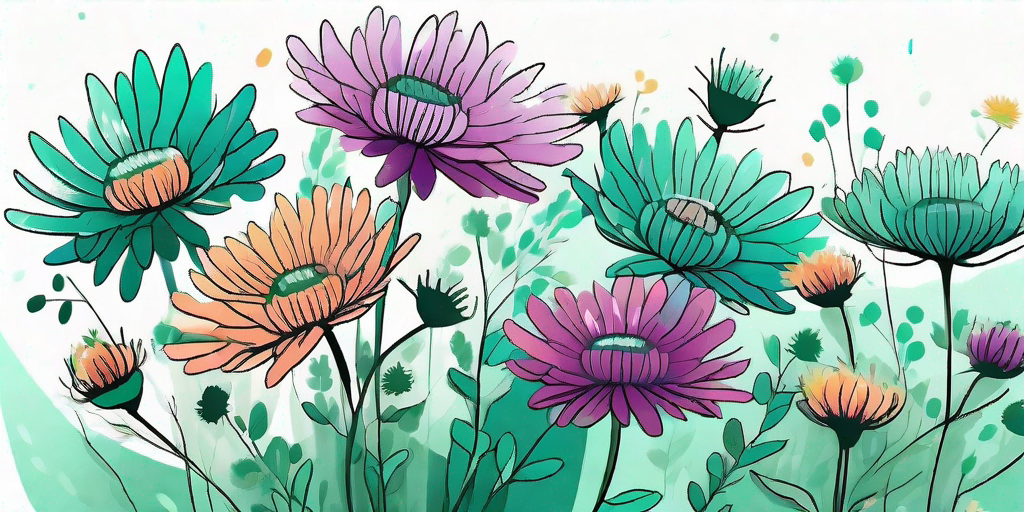
Asters, those vibrant, star-shaped beauties, are the unsung heroes of the garden world. Often overlooked in favor of roses or tulips, these hardy perennials pack a punch when it comes to adding color and charm to your garden. So, why not give these floral underdogs a chance to shine? Let's dive into the wonderful world of asters and discover how they can transform your garden into a riot of color.
Understanding the Aster: A Botanical Overview
Before we start planting, let's get to know our subject a little better. Asters belong to the Asteraceae family, which, with over 23,600 species, is the second largest family of flowering plants. They're like the Kardashians of the plant world, only more colorful and less controversial.
Asters are native to North America and Europe, but their charm has spread across the globe. They come in a variety of shapes and sizes, from the tiny alpine aster to the towering New England aster. But what they all have in common is their distinctive star-shaped flowers, which can range in color from white to pink to purple.
The Symbolism of Asters
In the language of flowers, asters symbolize love and patience. They're often given as gifts to celebrate anniversaries or to express admiration. So, planting asters in your garden is not just a horticultural decision, it's a statement of love and patience. And who couldn't use a little more of that in their life?
According to Greek mythology, asters were created from the tears of the goddess Astraea, who was so upset by the lack of stars on earth that she cried, and where her tears fell, asters bloomed. So, in a way, planting asters is like bringing a little piece of the night sky into your garden.
Planting and Caring for Asters
Now that we're all familiar with the history and symbolism of asters, let's get down to the nitty-gritty: how to plant and care for these floral gems.
Asters are pretty low-maintenance, which makes them perfect for gardening beginners or those of us who are a little forgetful when it comes to watering. They prefer full sun but can tolerate partial shade, and they're not too fussy about soil type, as long as it's well-drained.
Planting Asters
Planting asters is as easy as pie. Simply dig a hole twice as wide and as deep as the root ball, place the plant in the hole, and backfill with soil. Make sure the top of the root ball is level with the soil surface, and water thoroughly.
It's best to plant asters in the spring or early summer, to give them plenty of time to establish before winter. And remember to space them out - asters like their personal space, and overcrowding can lead to disease.
Caring for Asters
Once your asters are planted, they require minimal care. Water them regularly, especially during dry spells, and apply a layer of mulch around the base of the plant to conserve moisture and suppress weeds.
Asters are generally disease-resistant, but they can be prone to powdery mildew. To prevent this, make sure your asters have plenty of air circulation and avoid watering them from above.
Designing with Asters
Now that you know how to plant and care for asters, let's talk about how to incorporate them into your garden design. Asters are incredibly versatile and can be used in a variety of ways to add color and interest to your garden.
One of the great things about asters is their late blooming season. While most other flowers are starting to fade, asters are just getting started, providing a much-needed burst of color in late summer and fall.
Using Asters in Borders
Asters are perfect for borders, where their vibrant colors and tall stems can really stand out. Try pairing them with other late bloomers like sedum or goldenrod for a stunning fall display.
Or, for a more dramatic effect, plant a mass of asters in a single color. Imagine a sea of purple asters under a crisp autumn sky - it's enough to make any gardener's heart skip a beat.
Using Asters in Containers
If space is an issue, don't worry - asters can be grown in containers too. Choose a compact variety like the dwarf aster, and make sure your container has good drainage. Asters in containers can provide a pop of color on a patio or balcony.
And don't forget about cut flowers. Asters make excellent cut flowers, so you can bring a bit of your garden indoors. A vase of fresh asters can brighten up any room and make your home feel like a floral paradise.
FAQs about Asters
- Are asters easy to grow?
Yes, asters are very easy to grow. They're hardy, drought-tolerant, and disease-resistant, making them a great choice for beginners. - When do asters bloom?
Asters bloom in late summer and fall, providing color when many other flowers have faded. - Do asters attract wildlife?
Yes, asters are a great source of nectar for butterflies and bees, so they're perfect for a wildlife-friendly garden. - Can asters be grown in pots?
Yes, asters can be grown in pots. Just make sure your pot has good drainage, as asters don't like to sit in water.
Conclusion
So there you have it, everything you need to know about asters. These vibrant, hardy flowers are a great addition to any garden, providing color and interest when many other flowers have faded. Plus, they're easy to grow and care for, making them a great choice for beginners.
So why not give asters a try? Your garden (and the local wildlife) will thank you. And who knows, you might just fall in love with these floral underdogs. After all, as the saying goes, every dog has its day, and for asters, that day is definitely in the fall.















